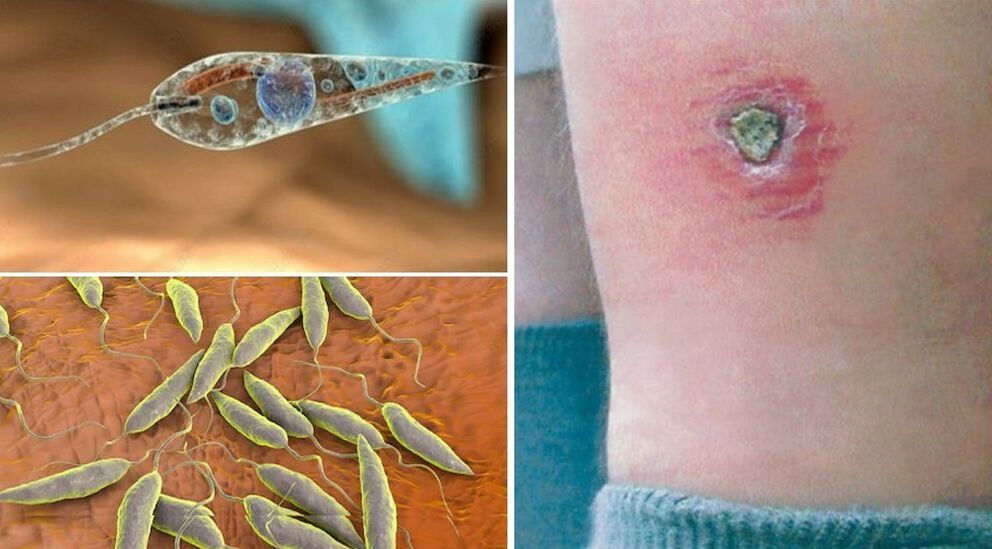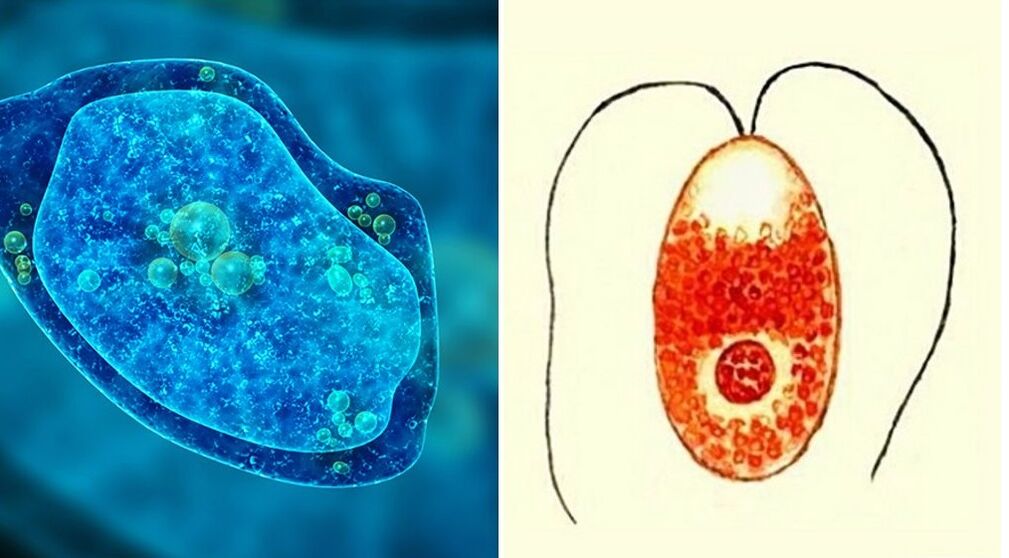Protozoal parasites in humans are the causative agents of protozoal (or protozoal) infection. These diseases are contagious and threaten serious complications and consequences. Therefore, the protozoosis requires timely diagnosis, accurate identification of the causative agent and appropriate treatment.
What are unicellular parasites
This is a group of unicellular microorganisms that are unable to produce nutrients on their own. Throughout life, they use other creatures and cause them serious diseases. The most common human protozoal parasites are listed below:
- Flagella - Giardia, Leishmania, Trichomonas, Trypanosoma;
- Sarkodal - dysenteric amoeba;
- ciliates - bursaria, balantidia;
- Sporozoa - malarial plasmodium, coccidia, piroplasma.
Trypanosoma
The simplest parasite, the life cycle of which occurs in the body of ungulates (antelopes) or an infected person. Carriers are tse-tse flies, which, when bitten by a person, inject saliva containing protozoa into his skin.
On a note!
The introduction of about 400 trypanosomes is necessary for the development of the disease (African trypanosomiasis or sleeping sickness). With one bite of a tse-tse fly, up to half a million individuals fall victim to the parasite.
Characteristics of parasitism and disease:
- Trypanosomes first circulate in the blood of an infected person, causing trypanids on the skin (swelling of the face, eyelids), fever with a temperature of up to 40 °C, swollen lymph nodes;
- then unicellular parasites migrate to the cerebrospinal fluid and cause drowsiness, iridocyclitis, chronic fatigue, lethargy, impaired speech, coordination;
- The advanced form of trypanosomiasis is characterized by spasms of the limbs, epileptic seizures, nervous and physical exhaustion, respiratory paralysis, coma and death.
To diagnose trypanosomiasis, the Romanovsky-Giemsa test, immunofluorescence reaction, enzyme immunoassay (ELISA) and puncture of the lymph nodes are used. Confirmation of the diagnosis is often made by placing a sick person's blood in laboratory pigs. Treatment of sleeping sickness involves taking special medications. Without therapy, there is a high probability that the patient will die.
Lamblia
Microscopic protozoa (synonyms - Giardia or Giardia) with four pairs of flagella are full-cycle parasites in the human body. Under certain conditions, they cause the disease giardiasis. Giardia is attached to the wall of the small intestine with a large suction cup and often settles in the ducts of the liver, gallbladder and other internal organs.
On a note!
Infection with protozoa occurs with food, water and in unsanitary conditions. Giardia cysts with embryos remain invasive in the environment for a long time (up to 3 months in fresh water, up to 4 months in sewage). Diagnosis of protozoa is carried out by microscopy of cysts and adults in feces, blood, detection of antibodies in the ELISA study.
Leishmania
These flagellated protozoa cause the disease leishmaniasis, which is common in tropical and subtropical countries. Infection occurs in a transmissible way - when bitten with the saliva of blood-sucking insects, animals (dogs, ground squirrels). Mosquitoes, mosquitoes, horse flies, ticks can be carriers. There are two types of leishmaniasis in humans:
- Skin and mucous form (Pendinskaya ulcer) - leishmania live and multiply in human skin, causing inflammation, swelling, ulcers, trophic ulcers, damage to the respiratory tract;
- visceral form - leishmania are settled in internal organs (spleen, liver, lungs, heart).
A characteristic sign of cutaneous leishmaniasis is the formation of brownish nodules (leishmaniamas) at the site of insect bites. Then they are replaced by round, hard-to-heal ulcers with purulent exudate. The disease drags on for 1-2 years, leaving scars on the skin. In the visceral form, leishmaniasis causes dysfunction of the adrenal glands, kidneys, liver, and spleen. When diagnosing leishmaniasis, they are found in the bone marrow, lymph nodes, skin scrapings, and blood.

On a note!
Treatment for leishmaniasis includes quarantine measures, patient isolation, and medication.
trichomonads
These are the simplest parasites of the human internal environment, which are transmitted from mother to child sexually, through household contact or as a result of a birth infection. There are oral, intestinal, and urogenital varieties of Trichomonas. Protozoa are the causative agents of trichomoniasis/trichomoniasis. Urogenital trichomoniasis of the genitourinary system is widespread. The chronic form of the disease threatens impotence and prolonged infertility. Features of Trichomonas parasitism:
- Body size - up to 18 microns, fast movement due to mobile flagella;
- resistant to drugs, determining the chronic course of trichomoniasis;
- die quickly in the environment, in the air, under the direct rays of the sun;
- stay on wet washcloths, sponges, towels, soap dishes for a long time;
- frequent infection during sexual intercourse of the vaginal, oral-vaginal type;
- Trichomonas contribute to the development of candidiasis, vulvitis, chlamydia, gonorrhea, cystitis.
The diagnosis of trichomoniasis involves the detection of trichomoniasis in swabs from the genitals. Treatment involves the use of drugs, treatment with antiseptics. The therapy is carried out with both partners in order to avoid relapses. Prevention of urogenital trichomoniasis includes measures recommended for all sexually transmitted diseases.
dysenteric amoeba
This sarcode microorganism is a parasite that causes dangerous diseases in humans. There are two forms of dysentery-amoebiasis - intestinal and extraintestinal (hepatic or pulmonary). The disease begins 7-10 days after infection with symptoms - bloody diarrhea, fever, vomiting.
If left untreated, the consequences of amebiasis develop - dehydration, exhaustion, weakness, internal bleeding, liver abscess. Infection is most commonly via the oral-faecal route. Carriers of amoebic cysts can be insects - flies, horseflies. When diagnosing, tissue forms of protozoa are found in feces. Treatment of amebiasis is inpatient with the use of antibiotics.

Malaria Plasmodium
Representatives of the simplest sporozoa, the causative agent of a dangerous disease - malaria. The human body serves as the incubator in which the life cycle of the parasite takes place. Characteristics of parasitism:
- infection with sporozoites of Plasmodium occurs when bitten by a malarial mosquito;
- Sporozoites enter the bloodstream with the saliva of an infected insect;
- Sporozoites settle in the liver, penetrate into its cells (hepatocytes);
- here merozoites are formed by mitotic replication;
- when hepatocytes are destroyed, merozoites invade erythrocytes;
- gametocytes are formed from merozoites as a result of the sexual cycle;
- a mosquito becomes infected with gametocytes when bitten by an infected person;
- in the body of a mosquito, gametocytes pass into oocysts, and then into sporozoites;
- a mosquito infects a healthy person, and the cycle repeats itself.
In humans, the destruction of erythrocytes and the release of gametocytes into the bloodstream is accompanied by flare-ups of fever, vomiting, anemia, cramps and joint pain. In severe cases, the risk of death increases. Malaria often assumes a relapsing character with phases of exacerbation and quiescence. Different protozoa cause three-day and four-day tropical malaria. The main therapeutic and diagnostic agent is quinine - naturally from cinchona bark or artificially synthesized.
Infusoria balantidia coli
This causative agent of the disease Balantidia (or infusor dysentery) lives in the large intestine and causes bleeding ulcers on its walls. Infection with protozoa occurs from domestic animals, mainly the carrier is a pig. Features of anatomy and parasitism:
- the body of the balantidia is ovoid with a dense, strong shell (pellicle);
- on the surface there are many cilia, which serve the movement;
- the sexual form of the parasite is necessary for reproduction by simple fission;
- asexual form (cysts) enters the environment with feces;
- The route of human infection with cysts is oral-faecal.
The resettlement of protozoa in the intestine is accompanied by headache, vomiting and dyspepsia in humans. The acute stage of balantidiasis is manifested by a febrile condition, signs of severe intoxication, loose stools with blood clots. Without timely treatment, a fatal outcome is possible.
Toxoplasma gondii
Microscopic crescent-shaped spore protozoa from the order Coccidia are widespread in the environment. They are the causative agents of the disease - toxoplasmosis. In healthy people, ingested pests are destroyed by immune cells. Features of the disease caused by protozoal parasites in humans:
- often toxoplasmosis is asymptomatic, after recovery immunity develops;
- the parasite affects the organs of vision, reproductive, nervous, lymphatic systems, liver, spleen;
- during pregnancy, toxoplasmosis causes severe congenital pathologies in the fetus or its death;
- the acute form proceeds with convulsions, paralysis, liver hypertrophy, heart problems;
- with a chronic course, functional disorders of the heart, damage to the organs of vision are possible.
The main hosts of protozoa are cats. Huge colonies of Toxoplasma form in their bodies from oocysts. Humans are intermediate hosts, they become infected through dietary, contact-household or oral-faecal routes.








































